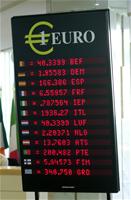The economic spring expected to be hot
Adelina Marini, March 22, 2011
![]() The dreamed golden ratio in the global economy seems to be hiding again behind the horizon with growing concerns of overheating in some emerging economies that are important for the global power balance. An analysis of the American think-tank Carnegie, by the authors Uri Dadush and Bennett Stancil, warns that Brazil and Indonesia are among the countries that are most exposed to the risk of overheating and that symptoms of temperature rise are visible in China, Argentina, India, South Korea, Mexico, Turkey and South Africa. The analysts note that these developments are still in their early stage and worsening of the situation could be pre-empted.
The dreamed golden ratio in the global economy seems to be hiding again behind the horizon with growing concerns of overheating in some emerging economies that are important for the global power balance. An analysis of the American think-tank Carnegie, by the authors Uri Dadush and Bennett Stancil, warns that Brazil and Indonesia are among the countries that are most exposed to the risk of overheating and that symptoms of temperature rise are visible in China, Argentina, India, South Korea, Mexico, Turkey and South Africa. The analysts note that these developments are still in their early stage and worsening of the situation could be pre-empted.
Even if it is drawing a parallel to the crisis that struck Asia in 1997, the analysis points out that a repeat of the Asian crisis is unlikely.
What are the symptoms?
The analysis of Uri Dadush and Bennett Stancil outlines three manifestations of overheating: domestic imbalances, financial asset bubbles and external imbalances. Domestic imbalances, according to the analysts, are indicated most clearly by the rising prices of goods and services. Financial asset bubbles occur when asset prices soar out of line with economic fundamentals (i.e. cease to be realistic) while external imbalances are outlined by particularly wide and unsustainable current account deficits.
The patients
According to Carnegie the symptoms of overheating are most clearly observed in Brazil where the output is nearly 10 percentage points over its 10-year pre-crisis trend. Inflation is 1.5 percentage points above target and rising, and the real effective exchange rate (REER) is an alarming 54% above its pre-crisis average.
In Argentina, too, domestic imbalances are also growing. The economic growth in the country that barely recovered from bankruptcy before years is well above the pre-crisis trend, inflation is more than 1 percentage point above target, and stock markets are up by nearly 60 percent since January 2008.
In India and Indonesia, GDP is also about 10 percentage points above trend and inflation is more than 2 percentage points above target. Compared to pre-crisis levels, Indonesia’s real exchange rate has risen by 23% and, relative to the pre-crisis average, its current account balance is expected to deteriorate by 3% of GDP over the next five years. India is also suffering from significant currency appreciation and current account “erosion”.
The property prices in China, where the state intervened, are a matter of concern too, but it is still early to forecast the results. Russia is struggling with high inflation and a rising currency, though the output is more than 10 percentage points below trend and stock prices are down by nearly 40 percent since 2008. Stock-market bubbles may be forming in Korea and Mexico. In South Africa and Turkey domestic imbalances can be observed.
According to Uri Dadush and Bennett Stancil the symptoms of overheating are limited in a few sectors of the economy and seem to be manageable. Nevertheless, the two analysts warn, these symptoms are a clear signal for wider problems which can easily spill to other economy sectors. Actually, the biggest danger for the emerging economies is not their current condition but the direction towards which they could be headed.
The problem faced by the political strategists in countries at risk (and not only by them) are the huge differences between the regions. The capital flows to Asia and Latin America are around or above their highest values while the capital influx to the emerging European markets (Bulgaria among them – in 2010 the country experienced a record downfall of foreign investment) remains by 70% lower compared to its 2007 level.
The Treatment
For the time being, the Carnegie analysts recommend domestic treatment and preventive measures for the less threatened patients that have to strengthen their immunity. The emerging markets, for example, have to act quickly in order to cushion the overheating effects and their first steps should be fiscal measures and  monetary discipline. The over-focusing on the exchange rates will attract, however, capitals and they, on their turn, will exert pressure on the currency rates. The latter is particularly dangerous for countries such as Brazil and Indonesia where capital overflow is already apparent.
monetary discipline. The over-focusing on the exchange rates will attract, however, capitals and they, on their turn, will exert pressure on the currency rates. The latter is particularly dangerous for countries such as Brazil and Indonesia where capital overflow is already apparent.
A possible measure could be the raising of buffers and limitation of crediting. The Carnegie analysts seem to approve Chinese monetary policy as they point out that the exchange rate is undervalued and its adjustment would cushion the inflation pressure. This will affect predominantly the prices of traded goods and, given the uncertainties in the global environment, caution in allowing large and rapid exchange rate appreciation is understandable, the authors comment.
The treatment could also involve the advanced economies that could have a key role in the overheating prevention. According to Carnegie, although they need to focus on their own condition, it is also important not to allow any delays in the needed fiscal measures. The goal is to prevent credit contraction and reduced risk appetite.
The signal from Uri Dadush and Bennett Stancil is extremely important, especially in a moment when the situation is being complicated by raising social unrest, multiplication of wars (Libya), natural disasters (as in Japan). All those are factors that encourage a rise in the price of resources accompanied by insecurity and – as a result – serious pressure on most global players against a reasonable domestic and monetary policy. euinside has more than once noted that globalisation is a fact for a long time and the butterfly effect is visible – every action or inaction of ours can cause serious damage on the other end of the world and return as a boomerang back against us.
 | © European Union
| © European Union | © European Union
| © European Union | © European Union
| © European Union